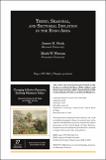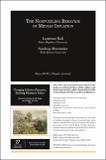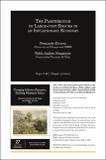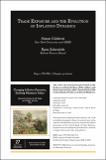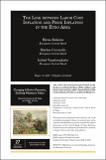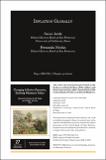Buscar
Mostrando ítems 1-20 de 29
The international financial system after Covid-19
In March of 2020, international markets seized up with a violence unequaled since the Global Financial Crisis (GFC) nearly a dozen
years before. As economies around the world locked down in the face of the potentially deadly but completely novel SARS-CoV-2 virus, stock markets fell, firms and governments ...
Exchange rate puzzles and policies
What is the optimal exchange rate policy? Should exchange rates be optimally pegged, managed, or allowed to freely float? What defines a freely floating exchange rate? Do open economies face a trilemma constraint in choosing between inflation and exchange rate stabilization, unlike divine coincidence ...
Cross-border corporate control: openness and tax havens
Cross-border corporate control is a major facet of globalisation. In roughly one out of four listed controlled companies in 2012, control was exercised by a foreign entity or family/individual. Controlling—and passive—ownership stakes are often hidden in complex structures, involving pyramids and ...
The reversal problem: development going backwards
The Covid-19 pandemic triggered the most synchronous economic downturn in more than a century. Ninety percent of countries posted a decline in real per-capita GDP in 2020, a share that surpassed any other year since 1900, which includes two world wars and the Great Depression of the 1930s.1 The health ...
International risk spillovers: implications for emerging markets’ monetary policy frameworks with an application to Chile
Among the factors behind international spillovers, U.S. monetary policy developments retain a major influence. Such developments
drive the global financial cycle as strongly demonstrated by Rey (2013), Miranda-Agrippino and Rey (2020), Miranda-Agrippino and
Rey (2021). The dramatic U.S. monetary ...
Global drivers and macroeconomic volatility in EMEs: a dynamic-factor, general-equilibrium perspective
A common view held by academics as well as policymakers assigns an important role to global factors as drivers of fluctuations in economic activity in emerging market economies (EMEs). This follows naturally from the fact that these economies are often small and open to trade in global goods and capital ...
How important is the commodity supercycle?
World commodity prices are known to display long cycles. These cycles have a periodicity of 20 to 30 years and are called commodityprice supercycles. Figure 1 displays the time paths of eleven commodity prices deflated by the U.S. consumer price index over the period 1960 to 2018. All commodity prices ...
Sovereign-Debt Crises and Floating-Rate Bonds
The choice of sovereign-debt maturity in countries at risk of default represents a complex set of competing forces. The tradeoffs reflect the underlying frictions present in international sovereign-debt markets. The primary frictions are the lack of state contingency in debt contracts and the inability ...
KFstar and portfolio inflows: a focus on Latin America
Policymakers faced with volatile capital flows may desire a method to identify the level of flows likely to persist in the medium
run. In a series of papers (Burger, Warnock, and Warnock, henceforth BWW, 2018, 2022), we have developed an estimate of the natural or equilibrium level of capital flows ...
Trend, seasonal, and sectorial inflation in the Euro Area
A central focus of monetary policy is the underlying rate of inflation
that might be expected to prevail over a horizon of one or two years.
Because inflation is estimated from noisy data, the estimation of
this underlying rate of inflation, which we refer to as trend inflation,
requires statistical ...
The nonpuzzling behavior of median inflation
For decades, textbooks have explained inflation behavior with
Friedman (1968)’s Phillips curve: the inflation rate depends on
expected inflation and the deviation of unemployment from its natural
rate. Yet this theory has always been controversial, and skepticism
has been rampant in the decade ...
The passthrough of large-cost shocks in an inflationary economy
This paper surveys and modestly extends the theory of menu-cost
models of the behavior of the aggregate price level after large-cost
shocks. It does so in the context of an economy with a high underlying
rate of inflation. It concentrates on the effect of large permanent and
unexpected increases ...
Trade exposure and the evolution of inflation dynamics
The Phillips curve—the relationship between price inflation
and fluctuations in economic activity— is a central building block
of economic models that allow for nominal rigidities and are relied
upon by central banks around the world to gauge cyclical inflationary
pressures and forecast inflation. ...
The three E’s of central-bank communication with the public
Central banks used to ask, “Shall we communicate this?” Now, as a rule, they ask, “Why wouldn’t we communicate this?” This
first wave of the revolution in central-bank communication is giving rise to a second wave. The question increasingly is, “How should we communicate this in a way that engages a ...
The transformation and performance of emerging market economies across the great divide of the global financial crisis
Before the Global Financial Crisis, a drive towards greater central-bank autonomy and transparency, as part of the achievement of greater central-bank credibility that had begun in the advanced economies (AE), spread to the emerging market economies (EME). This process was greatly enhanced by the ...
Fiscal inflation and cosmetic defaults in a small open economy
For a small open economy, maintaining a stable exchange rate and moderate levels of inflation is often a goal of primary importance. At the same time, the profession has recognized the tight link between fiscal and monetary policies in determining inflation dynamics. Thus, the goal of a stable exchange ...
The fiscal footprint of macroprudential policy
Monetary policies leave a fiscal footprint. When the central bank cuts the policy interest rate, this footprint comes through multiple
channels: The demand for currency rises, so the central bank prints more banknotes to accommodate it, and this creates seignorage revenues. Inflation unexpectedly ...
Inflation targeting under political pressure
Historically, many emerging economies, particularly in Latin America, battled against persistently high and volatile inflation. Today, emerging economies continue to experience higher inflation than developed ones, and their central banks deviate more frequently from inflation targets. These patterns ...
The link between labor cost inflation and price inflation in the Euro Area
To gauge inflationary pressures, policymakers generally pay close
attention to labor cost developments. A key reason has been the widely
held view that labor cost inflation (i.e., wage inflation adjusted for
productivity developments) is one of the main causes of price inflation.
From a theoretical ...
Inflation globally
The fortunes of the Phillips curve have ebbed and flowed ever
since it was proposed by Phillips (1958). Although its origins are
primarily as an empirical regularity, there is now a vast literature
that provides more formal justification. In recent times, the Great
Moderation and the modern era ...

